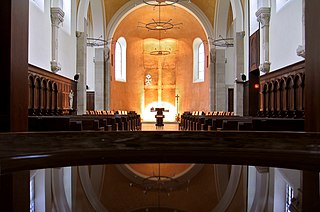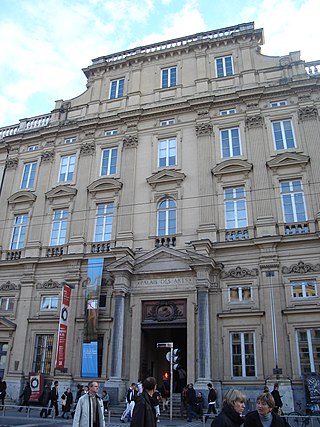
Montmartre is a large hill in Paris's northern 18th arrondissement. It is 130 m (430 ft) high and gives its name to the surrounding district, part of the Right Bank. Montmartre is primarily known for its artistic history, for the white-domed Basilica of the Sacré-Cœur on its summit, and as a nightclub district.

The Abbey of the Paraclete was a Benedictine monastery founded by Peter Abelard in Ferreux-Quincey, France, after he left the Abbey of St. Denis about 1121. Paraclete comes from the Greek word meaning "one who consoles" and is found in the Gospel of John (16:7) as a name for the Holy Spirit.

Saint-Pierre de Montmartre is the second oldest surviving church in Paris, after the Abbey of Saint-Germain-des-Pres. It is one of the two main churches on Montmartre, the other being the more famous 19th-century Sacré-Cœur Basilica, just above it. Saint-Pierre de Montmartre, begun in 1133, was the church of the prestigious Montmartre Abbey, destroyed in the French Revolution.
Faremoutiers Abbey was an important Merovingian Benedictine nunnery in the present Seine-et-Marne department of France. It formed an important link between the Merovingian Frankish Empire and the southern Anglo-Saxon kingdoms of Kent and East Anglia.

Saint-Lazare Prison was a prison in the 10th arrondissement of Paris, France. It existed from 1793 until 1935 and was housed in a former motherhouse of the Vincentians.

The Abbaye Blanche was a nunnery founded in 1112 in Mortain, France.

Jouarre Abbey is a Benedictine abbey in Jouarre in the département of Seine-et-Marne.

Louise Adélaïde de Bourbon was a French nun. She was the last Remiremont abbess and founded at the beginning of the Bourbon Restoration a religious community that became famous among French Catholics under the name of Bénédictines de la rue Monsieur. She constructed the Hôtel de Mademoiselle de Condé, named after her.

Montiéramey Abbey is a former Benedictine abbey at Montiéramey, in France, in the department of Aube, in France. It was partly destroyed during the French Revolution; the surviving buildings are now private dwellings.

Nivelles Abbey is a former Imperial Abbey of the Holy Roman Empire founded in 640. It is located in Nivelles, Walloon Brabant, Belgium.

The Abbey of Notre Dame aux Nonnains, also called the Royal Abbey of Our Lady of Troyes, was a convent founded before the 7th century in Troyes, France. The non-cloistered canonesses became wealthy and powerful in the Middle Ages. In 1266–68 they defied the pope and used force to delay construction of the collegiate Church of St Urbain. They were excommunicated as a result. Later the abbey adopted a strictly cloistered rule and the nuns became impoverished. Work started on building a new convent in 1778 but was only partially completed before the French Revolution (1789–99). The abbey was closed in 1792 and the church was demolished. The convent became the seat of the prefecture of Aube.

The hill of Montmartre became a place of popular pilgrimage after a chapel was erected by the people of Paris, around 475, where Saint Denis, the first bishop of Paris, was martyred. In the ninth century, the chapel, which had become ruined, was rebuilt. Archaeological excavations indicate that many Christians were buried in Montmartre. Their bones were gathered in a quarry on the side of the hill: the Martyrium or champ des morts.
The Abbaye de la Déserte or Abbaye Notre-Dame de la Déserte was a nunnery in Lyon, France. Founded in 1303 by Louis de Villars, Archbishop of Lyon, and Blanche de Chalon, who was also the first abbess, it housed the Poor Clares from 1304 till 1503, and then Benedictine nuns from 1503 to the French Revolution, when it was dissolved. It was demolished in 1814.

Préaux Abbey was a Benedictine monastery dedicated to Saint Peter at Les Préaux, in Normandy, France.
Preuilly Abbey was a Benedictine monastery in Preuilly-sur-Claise, Indre-et-Loire, France. The surviving abbey church retains many Romanesque features, notably the intricately carved capitals.

Montivilliers Abbey is a former Benedictine nunnery, founded between 682 and 684 by Saint Philibert in the town of Montivilliers in Normandy, in the present department of Seine-Maritime, France. It was suppressed during the French Revolution, but many buildings, including the church, have survived.
Guy-Claude-Roland de Laval-Montmorency, Count of Laval was a French military officer and a marshal of France.

Marie-Louise de Laval-Montmorency was a French noblewoman and nun who was the last Abbess of Montmartre. She was guillotined in the final days of the Reign of Terror during the French Revolution.

The Abbey of Saint-Pierre-les-Nonnains in Lyon, also known as the Abbey of the Dames de Saint-Pierre or simply Palais Saint-Pierre, is an ancient Catholic religious edifice that housed Benedictine nuns from the 10th century onwards, and was rebuilt in the 17th century. Closed during the French Revolution, the former abbey is now home to the Musée des Beaux-Arts de Lyon.















